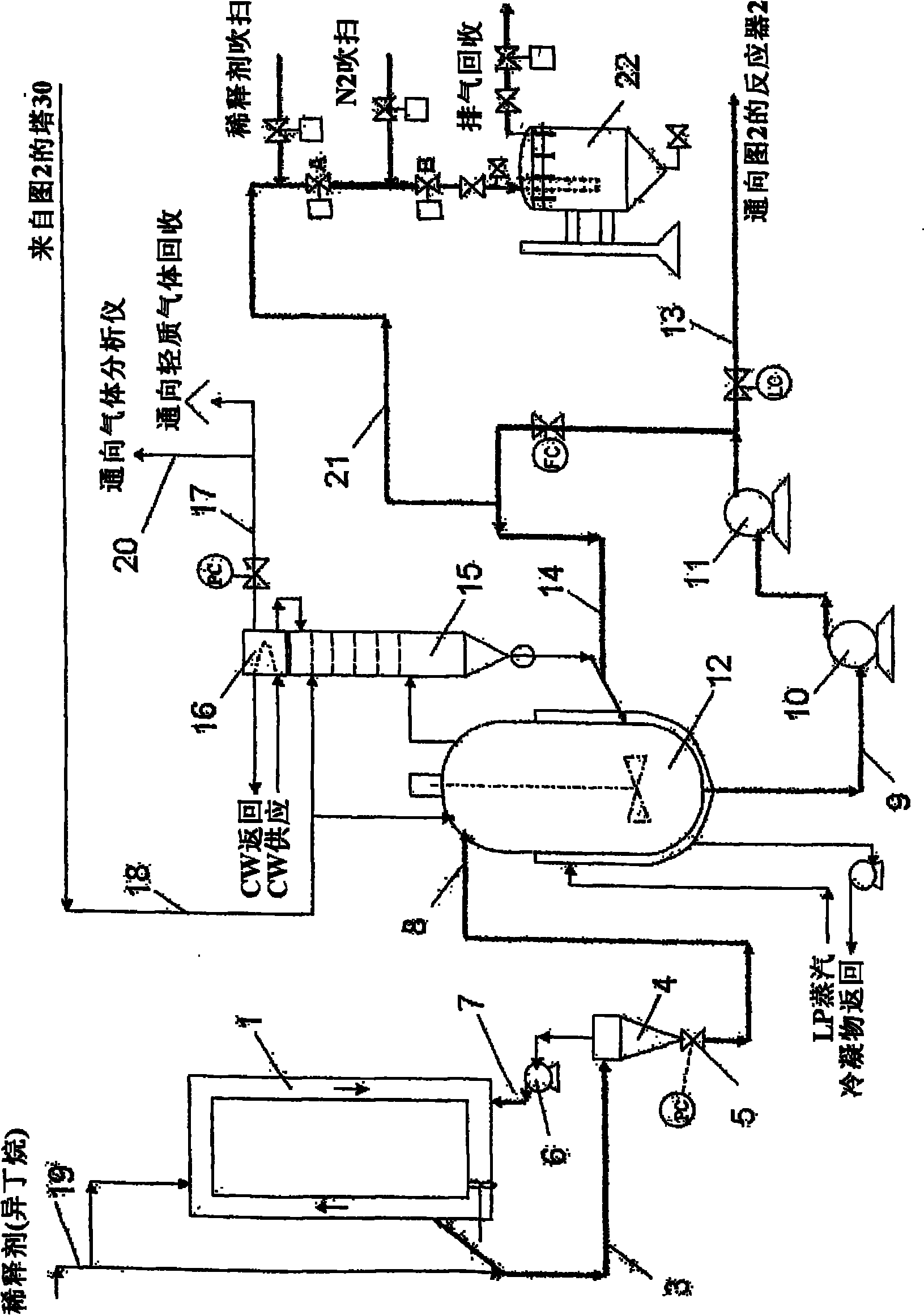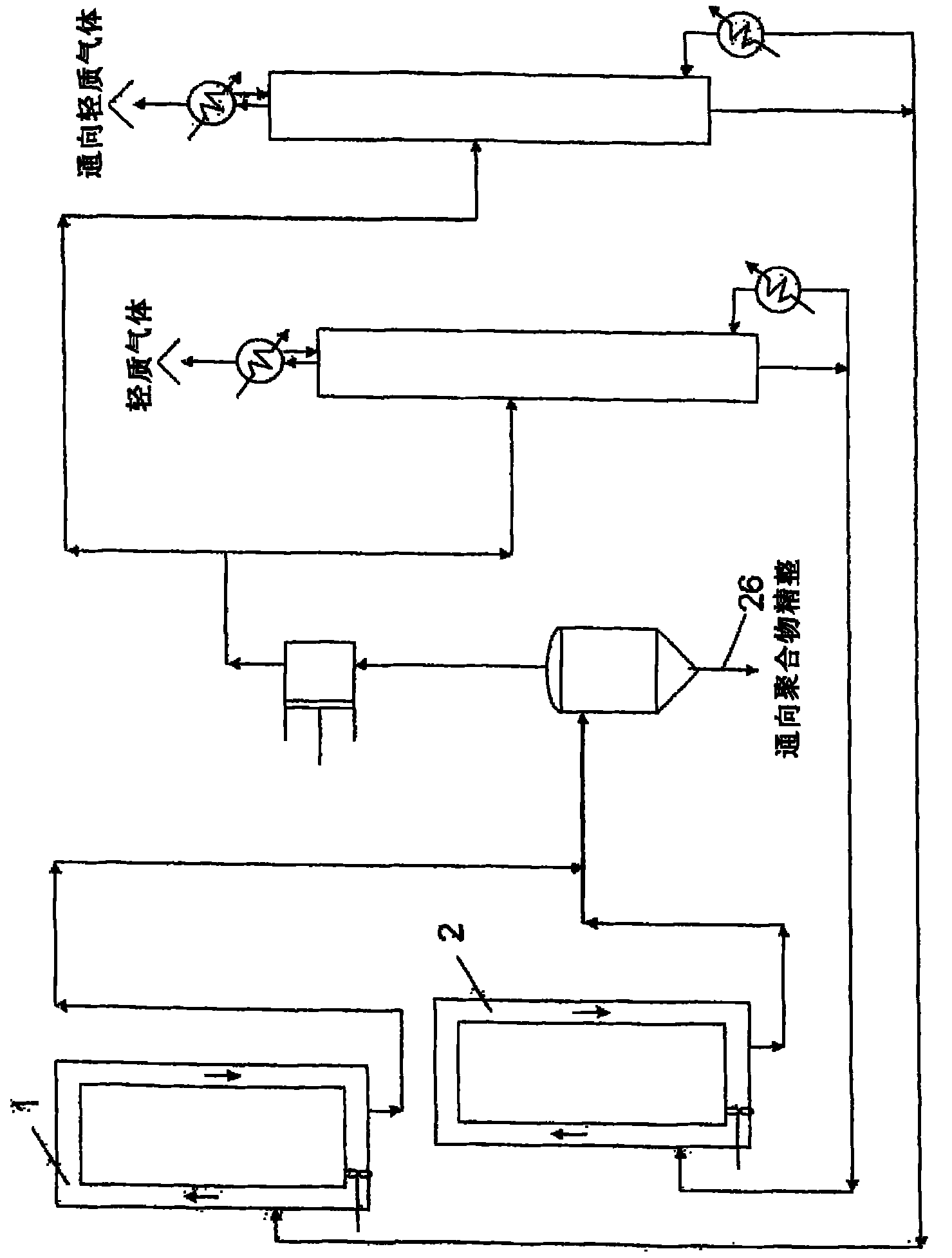Operation of multi-reactor polyolefin manufacturing process
A reactor, olefin polymer technology, used in the field of polyethylene
- Summary
- Abstract
- Description
- Claims
- Application Information
AI Technical Summary
Problems solved by technology
Method used
Image
Examples
Embodiment 1
[0063] Using the methods of the invention described herein and Figure 1-2 The equipment described in , for differential, bimodal grade polymer production. Ethylene is continuously polymerized in a first loop reactor 1 with isobutane using a Ziegler type catalyst in order to form a suspension comprising about 35% by weight of particles of low molecular weight ethylene homopolymer. The temperature in Reactor 1 was about 205°F and the pressure was about 550 psig. Reactor 9 was fed continuously with ethylene at a rate of 10 kpph. Some of the suspension of polymer particles formed in reactor 1 was withdrawn continuously through line 3 at a rate of 51 kpph. Reactor 1 was fed recycled isobutane diluent from distillation column 37 via line 19 at a total rate of 8 kpph. The suspension (S) contains about 35% by weight of polymer particles and is sent continuously to the hydrocyclone 4 . The operation of the hydrocyclone was controlled using the speed control of the pump 6 and the c...
Embodiment 2
[0069] Using the methods described in this invention and Figure 1-2 The equipment described in , for non-differential, unimodal grade copolymer production. The same circulation columns as in the previous example were used, but they were placed in a separate parallel configuration. Ethylene is continuously polymerized in a first loop reactor 1 with isobutane using a Ziegler type catalyst so as to form a suspension comprising about 39% by weight of ethylene copolymer particles. The temperature in Reactor 1 was about 185°F and the pressure was about 500 psig. Reactor 1 was continuously fed with an ethylene flow rate of 10 kpph, a hexene flow rate of 320 pph and a hydrogen flow rate of 1.2 pph. The hexene concentration in Reactor 1 was about 5.8% by weight. Some of the polymer particle suspension formed in reactor 1 was withdrawn continuously via line 3 at a rate of 51 kpph. Reactor 1 was fed recycled isobutane diluent and hexene from distillation column 37 via line 19 at a t...
Embodiment 3
[0077]For this example, using the same method and conditions as described in Example 1, the production of a differentiated, bimodal grade polymer was repeated, and the conversion of the product to a nondifferentiated, unimodal grade polymer ( Transformation using the same conditions and method as described in Example 2). The transition from bimodal to unimodal grade products was accomplished without any interruption of catalyst flow and involved simply changing the conditions in Reactor 1 (i.e., temperature from 205°F to 185°F, pressure from 550 psig to 500 psig , reduce hydrogen flow rate, increase hexene flow rate), light gas removal system, conditions in vessels 12 and 15 (i.e., pressure from 140 psig to 190 psig), conditions in Reactor 2 (i.e., increase hydrogen flow rate, increase pressure from 425 psig to 490 psig), and a simple line valve change to convert from the series operation of the circulation columns (30 and 37) described in Example 1 to the parallel operation o...
PUM
| Property | Measurement | Unit |
|---|---|---|
| melt flow index | aaaaa | aaaaa |
Abstract
Description
Claims
Application Information
 Login to View More
Login to View More - R&D
- Intellectual Property
- Life Sciences
- Materials
- Tech Scout
- Unparalleled Data Quality
- Higher Quality Content
- 60% Fewer Hallucinations
Browse by: Latest US Patents, China's latest patents, Technical Efficacy Thesaurus, Application Domain, Technology Topic, Popular Technical Reports.
© 2025 PatSnap. All rights reserved.Legal|Privacy policy|Modern Slavery Act Transparency Statement|Sitemap|About US| Contact US: help@patsnap.com



